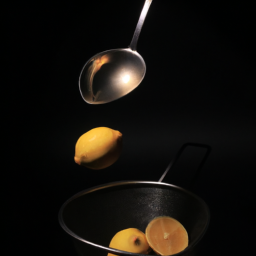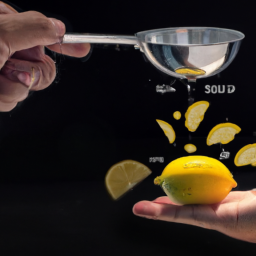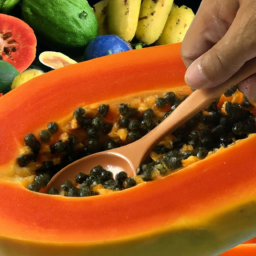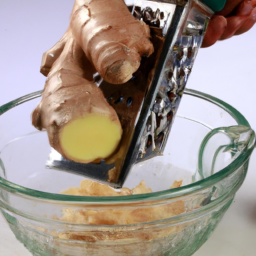As a home cook and frequent baker, I love using lemons to add a fresh, tangy flavor to my dishes. But following recipes that call for a specific amount of lemon juice can be tricky when precision is key.
How much juice can you expect to get from one lemon? The answer isn’t always straightforward, as it depends on a variety of factors.
In this article, I’ll guide you through the process of understanding the factors that affect lemon juice yield, as well as share tips for preparing and measuring lemon juice. I’ll also provide guidance on adjusting recipes based on lemon juice yield, storing lemon juice, and using lemon zest.
Whether you’re a seasoned cook or just starting out, understanding the nuances of lemon juice will help you take your dishes to the next level. So let’s get started!
Key Takeaways
- The amount of lemon juice yield is affected by the ripeness of the lemon and the amount of pressure applied when squeezing.
- Ripe lemons yield more juice and have higher acidity levels.
- Proper juicing techniques include applying enough pressure to release juice without extracting bitter oils from the rind and using tools such as citrus squeezers, mesh strainers, and hand-held juicers.
- One lemon generally yields around 2-3 tablespoons of juice but may vary based on size and ripeness, and measuring lemon juice is important for achieving desired taste and balance in recipes.
Understanding the Factors that Affect Lemon Juice Yield
If you want to get the most juice out of your lemon, it’s important to understand the factors that affect its yield.
The ripeness of the fruit and the amount of pressure applied when squeezing are two of the most important factors to consider when extracting lemon juice.
A ripe lemon will yield more juice than an unripe one. When a lemon is ripe, the flesh is softer and more pliable, making it easier to squeeze. Additionally, a ripe lemon will have a higher acidity level, which will result in a more flavorful and tangy juice.
When it comes to squeezing the lemon, it’s important to apply enough pressure to release the juice, but not so much that the bitter oils from the rind are also extracted.
With these factors in mind, you can extract the most juice from your lemon and create a delicious and flavorful addition to your dishes.
Now, let’s talk about the tools you can use to make the process even easier.
Tools for Extracting Lemon Juice
You’ll need a tool, like a citrus squeezer or reamer, to extract the tart liquid from that bright yellow fruit. While a lemon squeezer is the most commonly used tool, there are also some alternatives that you can consider. For instance, you could use a fork or a pair of tongs to press the lemon halves against a mesh strainer, or you could use a hand-held juicer that works like a garlic press. These alternatives may not be as efficient as a lemon squeezer, but they’re still effective at extracting lemon juice.
No matter what tool you use, it’s important to clean it thoroughly after each use to prevent bacteria buildup. The best ways to clean lemon extractors depend on the material they’re made of. If you have a plastic lemon squeezer, you can simply wash it with soap and hot water, or put it in the dishwasher. If you have a metal squeezer, you should avoid using abrasive sponges or harsh soaps that can scratch the surface. Instead, you can soak it in warm water with a little bit of baking soda to remove any residue. With these lemon squeezer tips in mind, you’re ready to move on to the next section about preparation tips for getting the most juice.
Preparation Tips for Getting the Most Juice
To maximize the amount of juice you can extract from a lemon, it’s important to roll the lemon firmly on a hard surface before cutting it open. This helps break down the internal membranes and makes it easier to release the juice.
It’s also important to choose the best types of lemons for juicing. Meyer lemons, for example, are sweeter and less acidic than traditional lemons, making them a great choice for those who want a less tart juice. When selecting lemons, look for ones that are heavy for their size and have a slight give when gently squeezed.
If you don’t have a citrus juicer, don’t worry! There are still ways to get the most juice out of your lemons. One tip is to use a fork to pierce the lemon and then twist it back and forth while squeezing. This helps to break up the pulp and allows the juice to flow more freely.
Another tip is to use a wooden reamer or spoon to press and twist the lemon halves while using your other hand to catch the juice. These simple techniques can help you get the most juice out of your lemons without having to invest in a fancy tool.
Now, let’s move on to squeezing techniques.
Squeezing Techniques
When squeezing a lemon, imagine you are wringing out a wet sponge, applying firm pressure to extract every last drop of tangy, citrusy goodness. There are two main techniques to extract the juice from a lemon: hand squeezing and electric juicing. Each method has its own pros and cons, depending on personal preference and the amount of juice needed.
Hand squeezing is the traditional way of juicing lemons. It requires a bit of elbow grease, but it’s a great way to get the most out of your lemons. To hand squeeze a lemon, cut it in half crosswise and hold it cut side down over a bowl or measuring cup. Squeeze the lemon with your hand, using your fingers to apply pressure and twist the lemon to extract as much juice as possible. The pros of hand squeezing are that it’s inexpensive, requires no electricity, and allows you to control the amount of pressure applied to the lemon. The cons are that it can be time consuming and may not be efficient for larger quantities of lemons.
| Lemon Juicing Accessories | Efficiency Rating (1-5) | Pros | Cons | Cost |
|---|---|---|---|---|
| Handheld Juicer | 3 | Easy to use, extracts a lot of juice | Can be messy, requires some strength | $5-10 |
| Citrus Press | 5 | Quick and efficient, easy to clean | Can be expensive, may not extract all juice | $20-50 |
| Reamer | 2 | Inexpensive, easy to use | Not efficient for larger quantities, may leave pulp and seeds | $5-10 |
If you want to juice a lot of lemons quickly, an electric juicer may be the way to go. Electric juicers are designed to extract the maximum amount of juice with minimal effort. Simply cut the lemon in half and place it cut side down in the juicer. The machine will do the rest. The pros of electric juicing are that it’s quick, efficient, and easy to use. The cons are that it can be expensive and may not be practical for occasional use. To get the most out of your lemons, choose the juicing method that best fits your needs and preferences.
Now that you know how to juice your lemons, it’s time to measure the juice for your recipe.
Measuring Lemon Juice
Nowadays, it’s common to measure the amount of citric liquid needed for recipes with measuring spoons or cups. Measuring lemon juice is an essential step in cooking and baking, especially when you want to achieve the perfect balance of flavors.
One lemon generally yields around 2-3 tablespoons of juice, but this may vary depending on its size and ripeness. A larger and riper lemon may yield more juice than a smaller and less ripe one, so it’s important to consider these factors when measuring.
Alternative methods of measuring lemon juice include using a juicer or a citrus press. These tools extract the juice from the lemon more efficiently and consistently than manual squeezing. However, they may also extract more of the bitter oils and pulp, which can affect the acidity levels of the juice. Therefore, it’s important to taste and adjust the lemon juice accordingly, especially if you are using it as a key ingredient in a recipe.
When adjusting recipes based on lemon juice yield, it’s important to be mindful of the acidity levels. Too much lemon juice can overpower other flavors and make a dish too tart, while too little can make it bland and lacking in brightness. Therefore, it’s always a good idea to start with a small amount of lemon juice and taste as you go, adding more if necessary.
With a little practice and experimentation, you can learn to measure and use lemon juice in a way that enhances the flavors of your favorite dishes.
Adjusting Recipes Based on Lemon Juice Yield
You can enhance the flavor of your dishes and achieve the perfect balance by adjusting your recipes based on the yield of your freshly squeezed citrus. Recipes modifications can be made according to the tartness or sweetness of the lemon juice. For example, if your recipe calls for the juice of one lemon, and you find that the lemon you have yields a small amount of juice, you may need to use more than one lemon to achieve the desired taste. On the other hand, if the lemon yields a lot of juice, you may not need to use a whole lemon.
To make recipe modifications based on lemon juice yield, it’s useful to have a reference chart that shows the approximate amount of juice that one lemon yields. Below is a table that demonstrates the amount of lemon juice you can expect from a small, medium, and large lemon. Keep in mind that these numbers are approximate and can vary depending on the ripeness of the lemon and how much pressure is applied when squeezing.
| Lemon Size | Amount of Juice |
|---|---|
| Small | 2 tablespoons |
| Medium | 3 tablespoons |
| Large | 4 tablespoons |
With this chart, you can easily adjust your recipes based on the amount of lemon juice you have on hand. Don’t let a shortage of lemon juice ruin your dish, or having too much lemon juice overpower it. By substituting and modifying your recipe based on your lemon juice yield, you can create the perfect balance of flavors. Now, let’s move on to the next section about storing lemon juice.
Storing Lemon Juice
Storing freshly squeezed lemon juice can be a great way to make it last longer and avoid wasting any leftovers. To store lemon juice, simply transfer it to an airtight container and refrigerate. The juice should stay fresh for up to five days in the refrigerator. It’s important to note that the longer the juice sits, the more its flavor and nutritional value will diminish.
To ensure that the lemon juice stays fresh, it’s best to use a container that’s just the right size for the amount of juice you have. This will help minimize the amount of air in the container, which can cause the juice to spoil more quickly. Additionally, you can try adding a small amount of sugar or salt to the juice before refrigerating it to help preserve its flavor and freshness.
Now that we know how to store lemon juice, let’s move on to another useful tip for getting the most out of our citrus fruits: using lemon zest.
Using Lemon Zest
I love using lemon zest in my cooking because it adds a burst of bright citrus flavor and aroma to dishes. Not only is it delicious, but lemon zest also has numerous health benefits. It’s high in antioxidants and vitamin C.
To get the most out of your lemon zest, it’s important to know how to grate it properly and store it correctly to ensure maximum freshness.
Benefits of Lemon Zest
Did you know that adding lemon zest to your dishes can enhance the flavor and provide additional health benefits? Lemon zest recipes are becoming popular due to the numerous benefits of this ingredient. Here are four reasons why you should consider incorporating lemon zest into your meals:
- Boosts immunity: Lemon zest contains high levels of vitamin C that help to strengthen the immune system.
- Promotes digestion: The citric acid in lemon zest stimulates the production of digestive juices, which aid in digestion and prevent constipation.
- Fights inflammation: The antioxidants in lemon zest can help reduce inflammation and protect against chronic diseases.
- Lowers cholesterol: The flavonoids in lemon zest have been shown to lower cholesterol levels, which can reduce the risk of heart disease.
By adding lemon zest to your dishes, you not only add a burst of flavor, but you also gain numerous health benefits.
Now, let’s move on to how to grate lemon zest for your recipes.
How to Grate Lemon Zest
Get ready to add an explosion of citrusy flavor to your meals by mastering the art of grating lemon zest! Grating lemon zest is a simple and easy process that requires only a few basic tools and techniques.
First, wash the lemon thoroughly and dry it completely. Use a fine grater or zester to remove the zest from the lemon. Be sure to only remove the colored outer layer of the peel, as the white pith beneath can be bitter.
There are several grating techniques to choose from, depending on your preferences and the recipe you are using. You can grate the lemon zest in long strips or tiny shreds, depending on how you plan to use it.
Lemon zest can be used in a variety of ways, such as adding flavor to baked goods, marinades, dressings, and cocktails. Get creative and experiment with different ways to incorporate lemon zest into your favorite dishes!
Now that you’ve mastered grating techniques and learned about lemon peel uses, it’s important to know how to store your lemon zest properly. So, let’s move on to the next section and discover some helpful storage tips for lemon zest.
Storage Tips for Lemon Zest
After learning how to grate lemon zest, it’s important to know how to store it properly to maintain its flavor and aroma. Here are some storage tips that I’ve found useful:
- Store lemon zest in an airtight container to prevent moisture from getting in and causing it to lose its potency.
- If storing in the fridge, place the container in the crisper drawer to keep it away from other foods and maintain a consistent temperature.
- If storing in the freezer, divide the zest into small portions and place them in separate freezer bags to make it easier to use later on.
- Label the container or bag with the date and amount of zest stored to avoid confusion and ensure freshness.
When it comes to leftover lemons, there are plenty of ways to use them up. One idea is to make lemonade or add slices to water for a refreshing drink. Another is to use the juice in marinades or dressings for a tangy flavor. And don’t forget about creative lemon zest recipes, such as lemon zest cookies or lemon zest pasta.
As for other uses for lemons, there are countless possibilities. From cleaning solutions to beauty treatments, lemons have a wide range of applications beyond just cooking. Let’s explore some of these options in the next section.
Other Uses for Lemons
I love using lemons for more than just cooking! Did you know that they can be used for cleaning, beauty treatments, and even as an insect repellent?
Lemon juice mixed with salt makes a great scrub for cleaning sinks and tubs, while lemon oil can be used as a natural furniture polish.
For beauty treatments, try using lemon juice as a toner or adding it to a face mask for brightening effects.
And if you’re looking for a natural insect repellent, try rubbing lemon juice on your skin or placing lemon slices around your outdoor gathering areas.
Cleaning
To effectively clean your kitchen with lemon juice, squeeze the juice of one lemon into a spray bottle with equal parts water and use it to wipe down surfaces. Lemon juice is one of the most effective cleaning solutions, especially when mixed with water. Not only is it a natural disinfectant, but it also cuts through grease and grime easily.
Here are some ways I use lemon juice to clean my kitchen:
-
For stubborn stains on countertops, I mix lemon juice with baking soda to create a paste. I apply the paste to the stain and let it sit for a few minutes before wiping it away with a damp cloth.
-
To freshen up my garbage disposal, I pour a cup of lemon juice down the drain and let it sit for a few minutes before running the disposal with cold water.
Using lemon juice to clean my kitchen is not only effective but also affordable and eco-friendly. Now, let’s move on to the next section about beauty treatments.
Beauty Treatments
When it comes to beauty treatments, using natural ingredients can be a great way to nourish your skin and hair. One such ingredient that’s often used in DIY beauty routines is lemon juice.
Lemon juice is rich in Vitamin C, which can help brighten your skin and even out your skin tone. It also has natural bleaching properties that can help lighten dark spots and blemishes.
DIY lemon facials are a popular choice for those looking to improve their skin’s appearance. Simply mix lemon juice with honey and apply the mixture to your face for 15-20 minutes before rinsing off with warm water.
Lemon juice can also be used in hair treatments to help remove buildup and add shine. Simply mix lemon juice with water and rinse your hair with the mixture after shampooing.
When it comes to natural remedies, lemon juice is a versatile ingredient that can be used in a variety of ways. However, it’s important to note that lemon juice can also increase your skin’s sensitivity to sunlight. So, it’s important to use sunscreen after any beauty treatment that involves lemon.
Now, let’s move on to the next topic: insect repellent.
Insect Repellent
As much as I love indulging in beauty treatments, I’m also excited to talk about natural alternatives and DIY solutions, like insect repellent. Commercial insect repellents can be expensive and contain harsh chemicals, but natural alternatives can be just as effective and more affordable.
Here are some DIY solutions I’ve found to be effective:
-
Lemon eucalyptus oil: This oil is just as effective as DEET in repelling mosquitoes. Simply mix 1 part lemon eucalyptus oil with 10 parts sunflower oil and apply to your skin.
-
Garlic: Believe it or not, garlic can repel mosquitoes due to its strong odor. Simply crush a few cloves of garlic and mix with water to make a spray.
-
Peppermint oil: This oil is great for repelling ants and other insects. Mix 10-15 drops of peppermint oil with 1 cup of water and spray around your home.
-
Apple cider vinegar: Not only is apple cider vinegar great for your health, but it can also repel insects. Mix equal parts apple cider vinegar and water and spray on your skin or around your home.
By using these natural alternatives, we’re avoiding harsh chemicals, saving money, and reducing our impact on the environment. Let’s give these DIY solutions a try and see how effective they can be!
Frequently Asked Questions
Can I use bottled lemon juice instead of fresh lemon juice?
Did you know that bottled lemon juice can have lower nutritional value compared to fresh lemon juice? While it may be convenient, consider using fresh lemons to ensure you’re getting the most nutrients.
How long does it take to extract lemon juice using different tools?
I tested three juicer options to see how long it takes to extract lemon juice. The hand juicer took 2 minutes, the electric juicer took 1 minute, and the citrus press took 30 seconds. The lemon juice yield was similar among all three options.
Can I use a blender or food processor to extract lemon juice?
Blender vs. hand squeezing for lemon juice extraction is like a race between a snail and a cheetah. While a blender is faster, hand squeezing yields better quality and longer shelf life.
What is the best way to store fresh lemon juice for long-term use?
To preserve fresh lemon juice for long-term use, I recommend storing it in an airtight container in the fridge. You can also freeze it in ice cube trays for easy portioning. The high citric acid content helps maintain its freshness.
Can I substitute lime juice for lemon juice in a recipe?
When it comes to cocktails, Lime vs Lemon: Which is Better? It really depends on the recipe, but both can add a zesty kick. And if you’re looking to make Lemon Lime Soda at home, a combination of both is the perfect blend. As for substituting lime juice for lemon juice in a recipe, go ahead and try it! Just keep in mind the flavor may be slightly different.
Conclusion
Well, that’s all there’s to know about how much lemon juice is in one lemon! I hope you’ve found this article informative and helpful.
Remember, the amount of juice a lemon yields can vary depending on many factors, such as the ripeness of the fruit, the size of the lemon, and the method of extraction used. By following the tips and techniques outlined in this article, you can get the most out of your lemons and add a bright, tangy flavor to your recipes.
For example, I’ve tried making a lemon meringue pie using bottled lemon juice, and it turned out okay. However, the filling lacked the bright, fresh flavor that I was hoping for. When I tried the recipe again using freshly squeezed lemon juice, the difference was amazing!
The pie was bursting with lemony goodness, and everyone who tried it raved about how delicious it was. So next time you’re tempted to reach for the bottled stuff, give fresh lemons a try – you won’t be disappointed!
Ilana has been a vegan for over 10 years. She originally made the switch for health reasons, but soon found herself becoming more and more passionate about the ethical and environmental implications of a vegan lifestyle. Ilana is the author of The Graceful Kitchen, a blog all about veganism. She loves to cook up delicious and nutritious vegan meals, and share her recipes with others who are interested in leading a cruelty-free life. Ilana is also a strong advocate for using whole foods as the foundation of a healthy diet, and believes that going vegan is one of the best ways to achieve this.










